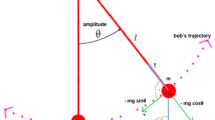Abstract
Dynamic behavior of a weightless rod with a point mass sliding along the rod axis according to periodic law is studied. This is the simplest model of child’s swing. Melnikov’s analysis is carried out to find bifurcations of homoclinic, subharmonic oscillatory, and subharmonic rotational orbits. For the analysis of superharmonic rotational orbits, the averaging method is used and stability of obtained approximate solution is checked. The analytical results are compared with numerical simulation results.



Similar content being viewed by others
References
Kauderer, H.: Nichtlineare Mechanik. Springer, Berlin (1958)
Bogoliubov, N.N., Mitropolsky, Y.A.: Asymptotic Methods in the Theory of Non-Linear Oscillations. Gordon and Breach, New York (1961)
Panovko, Ya.G., Gubanova, I.I.: Stability and Oscillations of Elastic Systems. Modern Concepts, Paradoxes and Mistakes. Nauka, Moscow (1987). in Russian
Magnus, K.: Schwingungen. Eine Einfuhrung in die theoretische Behandlung von Schwingungensproblemen. J. Teubner, Stuttgart (1976)
Seyranian, A.P.: The swing: parametric resonance. J. Appl. Math. Mech. 68(5), 757–764 (2004)
Seyranian, A.P., Belyakov, A.O.: Swing dynamics. Dokl. Phys. 53(7), 388–394 (2004)
Zevin, A.A., Filonenko, L.A.: Qualitative study of oscillations of a pendulum with periodically varying length and a mathematical model of swing. J. Appl. Math. Mech. 71(6), 892–904 (2007)
Belyakov, A.O., Seyranian, A.P., Luongo, A.: Dynamics of the pendulum with periodically varying length. Phys. D 238(16), 1589–1597 (2009)
Belyakov, A.O., Seyranian, A.P.: Dynamics of a pendulum of variable length and similar problems. In: Awrejcewicz, J., Hagedorn, P. (eds.) Nonlinearity, Bifurcation and Chaos—Theory and Applications, pp. 69–100. InTech, Rijeka (2012)
Markeev, A.P.: Uniform rotations of a variable-length pendulum. Dokl. Phys. 56(4), 240–243 (2011)
Markeyev, A.P.: The rotations of a pendulum excited by a high-frequency harmonic variation of its length. J. Appl. Math. Mech. 76(4), 388–392 (2012)
Koch, B.P., Leven, R.W.: Subharmonic and homoclinic bifurcations in a parametrically forced pendulum. Phys. D 16, 1–13 (1985)
Mann, B.P., Koplow, M.A.: Symmetry breaking bifurcations of a parametrically excited pendulum. Nonlinear Dyn. 46, 427–437 (2006)
Xu, X., Wiercigroch, M.: Approximate analytical solutions for oscillatory and rotational motion of a parametric pendulum. Nonlinear Dyn. 47, 311–320 (2007)
Melnikov, V.K.: On stability of a center under periodic in time perturbations. Trudy Moskovskogo Matematicheskogo Obshestva 12, 3–52 (1963). in Russian
Guckenheimer, J., Holmes, P.J.: Nonlinear Oscillations. Dynamical Systems and Bifurcations of Vector Fields. Springer, Berlin (1983)
Szemplińska-Stupnicka, W.: The analytical predictive criteria for chaos and escape in nonlinear oscillators: a survey. Nonlinear Dyn. 7, 129–147 (1995)
Kuznetsov, S.P.: Dynamical Chaos. Physmatlit, Moscow (2006). in Russian
Tabor, M.: Chaos and Integrability in Nonlinear Dynamics: An Introduction. Wiley, New York (1989)
Markeev, A.D.: Theoretical Mechanics. Nauka, Moscow (1990). in Russian
Volosov, V.M., Morgunov, B.I.: Averaging Method in the Theory of Nonlinear Oscillatoratory Systems. MSU, Moscow (1971). in Russian
Byrd, P.F., Friedman, M.D.: Handbook of Elliptic Integrals for Engineers and Scientists, 2nd edn. Springer, New York (1971)
Acknowledgments
This research was partly supported by the Austrian Science Fund (FWF) under Grant P25979-N25 and by the Russian Foundation for Basic Research (RFBR), Grant No. 13-01-00261.
Author information
Authors and Affiliations
Corresponding author
Appendices
Appendices
Melnikov function for homoclinic orbit
we denote \(M^{\pm } = 8\varepsilon \omega ^2 I_1 - 4\beta \omega ^3 I_2 + 4\varepsilon \omega ^3 I_3\), where
The integral \(\int _{-\infty }^{\infty }\frac{\sin \!\left( \eta /\omega \right) \mathrm{\,d}\eta }{\cosh ^2\!\left( \eta \right) }\) is zero because its integrand is an odd function, while the other integral has even integrand and can be calculated as follows: \(\int _{-\infty }^{\infty }\frac{\cos (t/\omega )}{\cosh ^2 t}\mathrm{\,d}t = \frac{\pi }{\omega \sinh (\pi /2\omega )}\); hence, the first term has the expression
The second integral can be calculated as follows:
while the integral \(I_3\) can be converted to \(I_1\) via integration by parts using the relation \(\frac{\sinh (s)\mathrm{\,d}s}{\cosh ^3(s)} = -\frac{1}{2}\mathrm{\,d}\frac{1}{\cosh ^2(s)}\) as
Thus, \(M^{\pm } = 8\varepsilon \omega ^2 I_1 - 4\beta \omega ^3 I_2 + 4\varepsilon \omega ^3 I_3 = \frac{6\pi \varepsilon \sin \left( \tau _0\right) }{\sinh (\pi /2\omega )} - 8\beta \omega ^2\).
Melnikov function for subharmonic oscillations
so we denote \(M^{p/q} = 8\varepsilon \omega ^2 k^2 I_1 - 4\beta \omega ^3 k^2 I_2 + 4\varepsilon \omega ^3 k^2 I_3\),
where we use the formula \(\frac{\mathrm{\,d}\mathrm{\,cn}(u)}{\mathrm{\,d}u} = - \mathrm{\,sn}(u)\,\mathrm{\,dn}(u)\). Thus, we have \(M^{q/p} = -12\varepsilon \omega ^{3} k^2 I_3 - 4\beta \omega ^3 k^2 I_2\).
The integral \(I_3\) vanishes except for \(p=1\) and even \(q\). In this case we have from (312.02) in [22]
where \(k'^2=1-k^2\). So we have (24).
Melnikov function for subharmonic rotations
so we denote \(M^{q/r} = 8\varepsilon \omega ^2 k^2 I_1 - 4\beta \omega ^3 k^2 I_2 + 4\varepsilon \omega ^3 k I_3\),
where we use the formula \(\frac{\mathrm{\,d}\mathrm{\,dn}(u,\frac{1}{k})}{\mathrm{\,d}u} = - \frac{\mathrm{\,sn}(u,\frac{1}{k})\,\mathrm{\,cn}(u,\frac{1}{k})}{k^2}\). Thus, we have \(M^{q/r} = -12\varepsilon \omega ^3 k^2 I_3 - 4\beta \omega ^3 k^2 I_2\).
The integral \(I_3\) vanishes except for \(r=1\). In this case we have
where \(K' = K\!\left( \sqrt{1-1/k^2}\right) \). So we have (30)
Rights and permissions
About this article
Cite this article
Belyakov, A.O., Seyranian, A.P. Homoclinic, subharmonic, and superharmonic bifurcations for a pendulum with periodically varying length. Nonlinear Dyn 77, 1617–1627 (2014). https://doi.org/10.1007/s11071-014-1404-3
Received:
Accepted:
Published:
Issue Date:
DOI: https://doi.org/10.1007/s11071-014-1404-3




